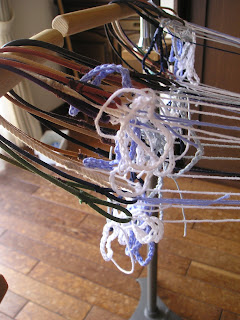裂き織のバッグの持ち手を組みました。一間組です。これまでは、組目がはっきり見えるように、反対色などのコントラストの強い色を合わせて組んできましたが、今回は以前に織った裂き織布に合わせて、紫と茶の濃淡計4色15ループで組みました。こういう配色もいいなと思いました。使用糸はコットンキングです。
Another way to braid longer braids is, as I discussed showing Ingrid Crickmore’s method, Catapilar. After wondering which is easier, I opted for the center-start which I got used to with Bansuishoku.
長さは55cmは欲しいので、90cmの糸を用意し、長さの中心から組み始めて端まで組み、中心に戻って反対側を組みました。写真でも分かると思いますが、糸が長い時ほど、締める力が弱いので1パターンの長さが長く、糸が短くなってくるとしっかり占めることができるので、1パターンの長さが短くなっています。パターンの長さは最大約1cmの差ができてしまいました。糸の長さに関わらず同じ強さで締めることができるようにならなければ。
でき上がりは、2.6cmx55cmになりました。バッグも仕上がりました。底の部分にはカーテン生地の端切れを使っています。
Braided a pair of bag handles in purple and brown, using a
technique of Single-unit braiding (ikken-gumi).
I have been using contrasting colors, like opposite colors, so that I
can clearly see the braiding. This time,
in order to match the torn-yarn woven fabric that I made some time ago, I chose
4 colors, dark and light purple and brown, 15 loops. This similar color combination is also nice,
I thought. The material is Cotton King.
I needed the length of over 55cm.
So I prepared 90cm long threads and started from the center of the
length, braided till the end, and started from the center again to the other
end. As you may be able to see from the
photo, the length of the pattern varies.
When you have long threads, your tightening power is weakened, making
the pattern length longer. With shorter
threads you can tighten firmly and get shorter patterns. The difference between the longest and the
shortest was about 1cm. I must train
myself to be able to tighten with constant power regardless of the thread
length.
Another way to braid longer braids is, as I discussed showing Ingrid Crickmore’s method, Catapilar. After wondering which is easier, I opted for the center-start which I got used to with Bansuishoku.
The finished braids are 2.6cmx55cm. I also finished the bag. The bottom part is a curtain remnant.














































